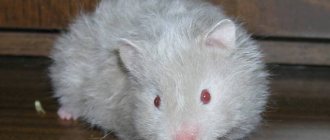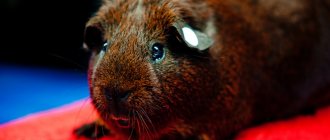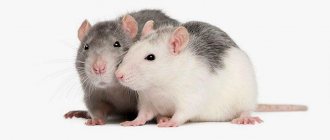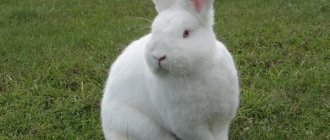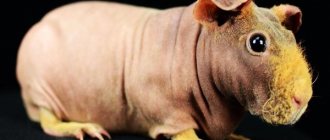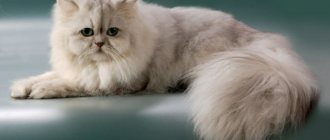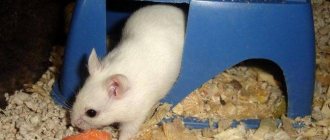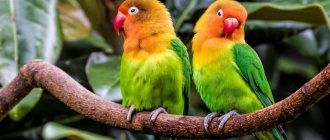The Syrian, or golden hamster, comes from distant Syria. It was first discovered in early 1839, and the single specimens found confirmed that it was a completely new species of rodent. For a long time there was no data on this species, until in 1930 Professor Aharoni brought three female golden hamsters to his laboratory. They had excellent contact with other inhabitants: chinchillas, gerbils and rats. In addition, golden hamsters turned out to be unpretentious and showed high fertility. It is these qualities that make it possible to keep this type of rodent at home.
Golden hamster
Golden hamsters are also called Syrian. Their main food is seeds and almost any type of grass. This type of hamster loves clover, alfalfa, various vegetables and fruits. Also, grain and cereal plant species are very suitable as food: wheat, oats, sunflower. You can give white pumpkin seeds.
In principle, golden hamsters are unpretentious in food and at home they adapt well to white bread. They can easily eat cereals and pasta. Those who are planning to keep a hamster of this type at home need to know that boiled meat should be added to the main diet. It is also necessary to give the animal multivitamins, as they react very sensitively to vitamin deficiency.
Females especially need a complete and balanced diet. Due to the fairly frequent births in females, as a rule, a lack of protein and mineral salts occurs in the body. Therefore, during the period when the female is pregnant, boiled meat and milk are given as feeding.
Like all rodents, golden hamsters are mobile and active creatures. During the daytime, these animals usually prefer to rest, but at night they are in full swing with life. Therefore, they need to be fed once a day in the evening.
Hamsters love to store food and the golden hamster is no exception. For these purposes, he has cheek pouches, which he stuffs every time he eats. In order for your pet not to hide food, you need to track exactly how much he can eat at one feeding and give only the right portion. Golden hamsters consume little liquid and drink milk very readily.
This type of hamster is quickly tamed and feels calm at home. They adapt quite easily and get used to humans. At the age of one month, the female can already bear offspring. The ability to bear children in females remains until the age of 1.5-2 years. As a rule, they reproduce well in captivity.
At home, it is better to keep the female and male separately from each other, in different cages. For mating, the female is placed next to the male. If the female is aggressive, then the hamsters are seated and the replanting is repeated after a few days.
Is it possible to give hamsters the same food in winter and summer?
The diet of animals is quite varied. It includes: grains, nuts, fruits and vegetables, protein products. Vegetables and fruits have a seasonal cycle. In the middle zone, cucumbers and plums grow in summer. At this time they contain a lot of vitamins. There will be no benefit from plums for the New Year. It was either grown somewhere far away, or treated with chemicals that protect against spoilage. This product should not be given to an animal. As for watermelons, it is better to exclude them from the diet altogether. They contain a lot of water, and nitrates added during cultivation are perfectly soluble in it.
It is better to prepare fruits in season. To do this, dry apricots and pears, and then add them to your pet. Instead of greenhouse cucumbers, feed the animals carrots and turnips, which retain vitamins well; apples can be given as fruit.
GOLDEN SYRIAN HAMSTER
Class: mammals. Order: rodents. Family: Hamsters. Genus: medium sized hamsters.
Species: Syrian hamster.
Habitat in nature: in nature, Syrian hamsters are found in Asia Minor, Western Bulgaria and Eastern Turkey. Life expectancy: 1.5 - 2, maximum 3 years. Average indicators: body length – 11-12 cm, tail – 1.5 cm. Weight 100-125g.
Description The Syrian hamster is a medium-sized rodent, with a dense body, short legs and a small head with a pointed muzzle. The ears are small, but clearly visible above the surface of the coat, the eyes are round and protruding. Eye color can be different (dark and red) depending on the color. The coat is soft and thick, the color is golden brown. Through selective breeding, both short-haired and long-haired hamsters were obtained. Based on their coat type, they can be divided into satin, wavy-coated, and hairless. Currently, the color of the Syrian hamster can be golden, black, silver, white, brown, gray, sable, ivory and many others. Males have longer hair than females.
Character
Hamsters are lively, active and funny animals, but by nature they are more likely to be self-sufficient loners and will be happy, calm and contented in “splendid isolation”. They are quite sociable and can be completely tame with the person who feeds them. When keeping two or more hamsters that have reached sexual maturity, you can expect quarrels and fights, which often lead to injuries.
Relationships with other pets
Hamsters are shy animals with a weak nervous system. You should not get these rodents if there are other pets in the family, whose sight and voices can make the hamster faint. Free-ranging rats can be dangerous for a hamster in a cage. Cats, dogs, especially hunting breeds, rats and large birds can be dangerous for an escaped animal.
Attitude towards children Hamsters are nocturnal rodents and babies trying to wake up the hamster to play with him will only irritate and irritate him. In addition, constant awakenings are harmful to the health of the rodent. They are more suitable for older children - schoolchildren or teenagers, who can watch them both at home and in a lively corner of the school.
Taming
Hamsters have almost no intelligence, but there is evidence that Syrian hamsters, unlike, for example, Djungarian hamsters, can be trained to use a jar or small tray as a toilet. Syrian hamsters make contact quite quickly and are quite easy to tame. When communicating with this animal, you should speak softly and try not to make sudden movements. Taming can be started by giving a treat from your hand. An animal that has become accustomed to being held in a hand can gradually allow itself to be picked up.
Nutrition
The predominant grains in a hamster's diet should be wheat, oats, millet, barley, buckwheat, rice. You can offer sunflower seeds, pumpkin seeds, melon seeds, boiled peas and beans. Juicy greens are an important addition to the basic diet, allowing you to replenish your vitamin supply. Good options include clover, dandelion (a little), nettle, sedge, burdock, plantain, parsley, dill, lettuce, celery. In winter, fresh, high-quality hay or grass grown in a pot will do. You can also use vegetables and fruits as succulent food - carrots, pumpkin, zucchini, cucumber (not bitter), radishes, apples, pears, plums, dried fruits. In addition to plant food, hamsters also need animal protein. They can be given hamarus, grasshoppers, beetles, finely chopped boiled meat or chicken, a little low-fat cottage cheese or egg whites. Hamsters drink little water, but it should always be in the cage, fresh and filtered.
It is convenient to feed your hamster twice a day, morning and evening, offering most of the diet in the evening, since hamsters are most active at night.
Hamsters should not be fed “from the table”; give them onions, leeks, garlic, citrus and exotic fruits, and breakfast cereals. Digestive disorders in animals can be caused by cabbage, mushrooms, bananas and pasta. Fruit seeds are also contraindicated due to their hydrocyanic acid content.
At home, the golden hamster can be kept both in a cage and in a terrarium. In a terrarium, the animal is interesting to watch, like fish in an aquarium, but there may be problems with air circulation and humidity. In addition, the terrarium is more difficult to clean. A cage for one hamster should be metal, but not copper, with horizontal rods. The distance between the rods should not exceed 10mm. The minimum cage size for one hamster is 50cm x 25cm x 30cm. The presence of a tray makes cleaning the cage much easier. Hamsters, like all small mammals, do not tolerate loud noises, drafts, direct sunlight, high humidity and drafts. The combination of high humidity and low temperature is detrimental to the health of this rodent. The curtains that the hamster can reach will be torn and used to build a nest, while strips of fabric can injure his limbs. There should not be any wooden parts in the cage, with the exception of shelves inside the cage, since hamsters quickly chew through wood and run away. They put food bowls, porcelain or metal, in the cage so that the animal does not knock them over or chew them, attach a drinking bowl, preferably with a dispenser, put a wheel and a house where the animal will arrange a place to rest. As materials for building a nest, you can offer hay, small twigs, roots, pieces of fur, strips of unpainted paper. To grind down the incisors, put twigs of apple, pear, willow with bark or special wooden toys for rodents (food coloring should be used for their manufacture), and fix a mineral stone for rodents.
Two-level cages with ladders, tunnels and houses located at different levels are well suited for hamsters. As bedding, you can use shavings of deciduous trees or rodent litter sold at a pet store. On the bottom of the cage you can attach a strip 25-30mm high, which will prevent the litter from spilling out. The bowls are washed daily, the bedding is changed as needed, but at least three times a week, the entire cage, including the wheel and toys, is washed once a week, and spoiled supplies made by the hamster are removed. You cannot remove all the supplies made by the animal, since the hamster will be very nervous when it discovers that all the supplies are missing. Once a month, the cage should be disinfected after washing.
If the hamster escapes from the cage or during a “walk,” put the cage on the floor and put your favorite treat in it: the rodent will return home on its own.
Diseases Healthy animals are active, curious, and alert. They eat well and store food. They have well-groomed fur and clean, bright eyes. Non-communicable diseases
Obesity, respiratory diseases, diarrhea when eating large amounts of greens, clogging and damage to the cheek pouches, tumors of various etiologies, allergies of various etiologies, rickets, damage from bites, when keeping several animals together
Infectious diseases caused by viruses, microorganisms and parasites Scabies, enteritis, cystitis, parasitic infections, pasteurellosis, pseudotuberculosis, paraphyte, leishmaniasis.
A little history
The first description of hamsters appeared in the book “Natural History of Aleppo by Alexander Russell,” published in 1797. In 1840, another researcher, George Robert Waterhouse, published information about the same species of hamster, calling it the Syrian or golden. Until 1930, it was believed that this species of hamster had disappeared in the wild, since not a single animal could be found in the vicinity of Aleppo (Syria). In 1930, zoologist Israel Aharoni, who went in search of an animal he needed for scientific research, found a hamster burrow, where he discovered a female with cubs. The whole family, placed in a box, is sent to the University of Judaism. Unfortunately, by the end of the trip, only four babies remained alive - one female and three males. Since no other Syrian hamsters could be found in the wild, this family became the basis for breeding Syrian hamsters in captivity. Descendants of these hamsters were sent to England and France, and in 1938 the first Syrian hamsters appeared in the United States. In the same year, scientists came to the conclusion that these hamsters became extinct in nature. In 1948, a Munich fur trader brings the animals from the United States to Germany, believing their fur might be valuable, but discovers that the hamsters make excellent pets and begins breeding them, establishing a kind of nursery. Around the same time, breeding and selective breeding of these rodents began in different countries, which became very popular as pets. In 1977, a group of biologists led by Professor Gattermann, conducting research in eastern Turkey, discovered Syrian hamsters and several individuals of the newly discovered species were imported to Germany, where scientists at the University of Halle began breeding and researching them. When comparing wild and domestic Syrian hamsters, no significant differences were found.
In Europe and North America, rodent exhibitions have long been held, in which hamsters of various species are full participants. Experienced experts evaluate exhibited animals in accordance with the breed standard. In Russia, the first exhibitions with the participation of hamsters began to be held quite recently, although experts have already appeared who are sufficiently qualified to evaluate the exhibited rodents according to the breed standard.
What can you feed a hamster that is left without a mother?
It is a great misfortune if the babies lost their mother at birth or she escaped from the cage.
You'll have to arm yourself with patience and take care of the little hamsters yourself. Of the mixtures, milk is best suited for feeding kittens. You can buy it at a pet store. Give your babies the diluted formula every two hours. After eating, massage their tummy. Give the animals bottles of warm water to prevent them from catching a cold.
As they grow, their diet becomes richer. Add baby purees without salt and sugar to your animals:
- vegetable;
- fruit;
- meat.
Cook porridge with water for them. A month-old animal can be fed with adult food. If necessary, grind it on a grater.
Origin of the species and description
Photo: Syrian hamster
The Syrian hamster is a chordate animal. They are classified into the class of mammals, the order Rodents, the family Hamsters, the genus Medium hamsters, and the species Syrian hamsters. Initially, the name golden hamster was assigned to them thanks to zoologist Georg Robert Waterhouse. On the recommendation of Charles Darwin, he compiled a list of animals that arrived from the expedition on the Beagle. Among the diversity of representatives of the animal world, there was the only representative of this breed.
Video: Syrian hamster
This species of animal was first described by the English scientist, zoologist and researcher George Robert Waterhouse in 1839. The scientist mistakenly considered it an extinct species. This assumption was refuted in 1930, when another scientist Israel Aharoni, during his expedition, discovered a Syrian hamster - it was a pregnant female. The scientist transported this hamster to the University of Judea, where the female safely gave birth to 11 small hamsters. Subsequently, of the entire brood, only three males and the female who gave birth to them remained alive.
Scientists tried in vain to find other individuals of this species in natural conditions. However, they never managed to do this. Then Akhoroni came up with the idea of crossing a female Syrian hamster with a male of a related species. This couple became the progenitors of a new species. Around 1939-40, the resulting offspring were transported to the United States of America. After another 1.5-2 years, scientists finally came to the conclusion that the Central Asian hamsters had become extinct, and there were no more representatives of this species in natural conditions.
In the process of studying Syrian hamsters, it was found that they have a dental structure similar to that of humans, and therefore they were used in laboratory conditions to study dental diseases. To date, scientists have not been able to answer the question of what caused the extermination of this species of animals.
Description
The golden hamster is a small rodent. Body length varies from 13 to 15 cm, weight - 110-150 g. The body is dense, the coat is smooth, the tail is short - no more than 0.5 cm long.
Not only the body, but also the small ears of the rodent are covered with fur of this shade. The golden hamster's legs are stocky and its feet are wide. The eyes are large and black. A distinctive feature of this breed is its ability to constantly fill its cheek pouches with food. Therefore, if you see a golden-colored rodent in the photo, and with cheeks full of food, there is no doubt - this is a Syrian hamster.
Like most breeds of the Hamyakov family, this species is nocturnal. During the day, hamsters sleep, and at night they exercise on a wheel, ladder and other devices for active pastime.
Advantages of the breed
Unlike other dwarf rodents, this species is universal because it is suitable for people of all ages, including children. Golden hamsters are less active than their counterparts due to their weight and size. They don't bite. They can be easily tamed. By its nature, this breed is considered the most obedient and non-aggressive.
Another feature of this species is the need to live alone. This is exactly the species that does not tolerate the proximity of other individuals in the cage. Remember, keeping hamsters of this breed together can lead to irreversible consequences. Such rodents can not only injure each other, but also bite to death.
Until about five weeks of age, young animals can feel comfortable in the community. After this, all individuals need to be seated in different cells. Some rodents may not show any aggression towards each other, but experience severe stress from having to share their territory with other individuals.
Appearance and features
Photo: Syrian hamster boy
Syrian or golden hamsters were bred in laboratory conditions from wild hamsters brought from Syria by zoologists in the last century. The body length of an adult is approximately 13-15 centimeters. Average body weight is 200-300 grams. This species is characterized by sexual dimorphism. Female individuals have a larger and stockier body. At the same time, the body length of females is slightly less than that of males. Another distinctive feature is the shape of the back. In females it is straight, in males it has a pointed shape. Individuals can also be recognized by the number of nipples. Females have four of them, males have only two.
Animals have a specific structure of their limbs. They have 4 toes on their forelimbs and five on their hind limbs. Most individuals of this species are golden in color, but individuals of other colors may occur.
What colors of Syrian hamsters can be found:
- copper;
- chocolate colors;
- sable;
- beige;
- honey;
- dark chocolate color.
The color may be uniform or have spots of a different color. The body of Central Asian hamsters is covered with thick and soft hair. Golden hamsters come in long-haired and short-haired varieties. The hamster's muzzle has a round, slightly elongated shape. There are small, rounded ears on the side of the head. The hamster's eyes are large, round, black, shiny. The nasal part of the animals is framed by whiskers. Hamsters have a small, short tail that is almost invisible in their thick fur.
Where does the Syrian hamster live?
Photo: Syrian or golden hamster
Today, Syrian hamsters are not found in natural conditions. They exist exclusively in artificial conditions as pets. The founders of this species are wild hamsters, which were brought by a zoologist from Syria. This type of hamster has been purposefully bred in the United States. At the time of the existence of animals in natural conditions, they preferred to live in desert regions with a dry climate. The natural habitat of small rodents was quite wide.
Geographic regions where hamsters live:
- countries of Asia Minor;
- central regions of Africa;
- Southeast Asia;
- certain regions of the European continent;
- North America;
- South America.
Golden hamsters are considered not at all picky animals. They can adapt to living in almost any conditions: in steppes, forest-steppes, forests, even in mountainous areas. Some individuals lived in the mountains at an altitude of more than 2000 above sea level. Park areas, agricultural fields, orchards, and vegetable gardens were also not an exception. Small rodents choose small but deep burrows as their place of residence. It is worth noting that the hamsters chose those regions as their habitat that had enough food for the normal functioning of the animal.
Conditions of detention
Golden hamsters love spacious cages. It is best to take a metal one designed for keeping rabbits. Some people prefer to use aquariums, rectangular glass containers or terrariums as cages.
The size of the cage for two hamsters should be 50x40x40 cm. There must be a wooden house inside so that the rodents can take refuge and rest there. In addition, the presence of a house has a beneficial effect on the breeding of offspring. Golden hamsters arrange their own house, dragging straw, paper or scraps of rags there.
The air temperature where the hamsters are located should not be lower than 22 °C. If the temperature drops below that, the animal may hibernate.
What does the Syrian hamster eat?
Photo: Syrian hamsters
Syrian hamsters are considered almost omnivorous animals. The source of nutrition can be either plant food or food of animal origin. As a last resort, rodents eat larvae, ants, small bugs, etc. Hamsters living in natural conditions eat almost anything they can find and eat. These can be seeds, roots of various types of vegetation, berries, juicy fruits, herbs, etc.
Interesting fact: Science knows of cases where golden hamsters living in natural conditions ate their cubs.
If an animal is kept at home, it is important to understand that human food is completely unsuitable for it. A person whose home contains a small fluffy rodent must become familiar with the rules and feeding habits of the animal, as well as avoid overfeeding and ensure a balanced diet. It is strictly forbidden to feed hamsters sweet, salty or fatty foods. Despite the fact that these little animals simply love sweets, their digestive system is not able to digest such foods. This can cause the death of the animal.
The basis of a pet hamster's diet should be dry, balanced food. It is easy to purchase at any zoological supply store. The dry mixture must contain vitamins and minerals, and must also be intended exclusively for hamsters, and not for any other animals or birds. However, you shouldn’t limit yourself to dry food only. In order for the animal to be active and healthy, it will also need wet food.
What can you give hamsters as wet food:
- greenery;
- lettuce leaves;
- fruits;
- vegetables;
- berries;
- carrot;
- zucchini.
In small quantities, you can add dried fruits to your diet and always low-fat cottage cheese without any additives. When keeping at home, care must be taken to ensure that the animal always has clean water available for drinking.
Now you know what you can give Syrian hamsters at home and what not. Let's see how golden hamsters behave in their natural environment.
Diet
Mixtures containing 20% fat, carbohydrates, fiber and protein are used as food for rodents. The daily norm for an adult rodent is 50 g, namely:
- grain mixture – 15 g;
- white bread – 5 g;
- root vegetables, fresh vegetables – 30 gr.
Rodent food must be chosen carefully. Firstly, the mixture must include nutrients, and secondly, vitamins and minerals. Since golden rodents are extremely sensitive to a lack of vitamins, their food consists of: oats, flax, corn, millet. As for fresh vegetables, these are carrots and lettuce.
When giving fresh vegetables to your hamster, you need to ensure their freshness. Rotten vegetables cause problems in the digestive system, which is why it is so important to keep the feeder clean. Water should be at room temperature and always clean.
Interestingly, golden hamsters prefer milk over water. But this does not mean that there should only be a milk drink in the cage.
Features of character and lifestyle
Photo: Syrian hamster girl
The golden or Syrian hamster is considered a nocturnal animal. He sleeps almost all day, waking up only to satisfy his hunger. But at night he wakes up and becomes very energetic. In natural conditions, hamsters constantly dig the ground. They are able to dig an almost unlimited number of earthen passages and holes. Hamsters tend to lead an isolated lifestyle. Each individual needs its own home. This should be taken into account when keeping animals at home. Rodents tend to store food. They put food in their cheek, then take it out and eat it.
Interesting fact: The cheek space in which hamsters store food can hold a volume of food that is almost three times the size of the animal’s head. The small rodent itself is capable of storing up to 13-15 kilograms of food, which can exceed its own body weight by 100 times!
With the onset of darkness, incredible animal activity is observed. In natural conditions, this helped them escape from numerous enemies. At night, the animals are engaged in arranging their homes, preparing food supplies and consuming them, and can also simply frolic and play. In natural conditions, hamsters tended to lead an isolated, rather solitary lifestyle. Juveniles could sometimes form small groups. Having reached sexual maturity, hamsters begin to fight for territory, food supply, etc. Often such disputes end in death for weaker individuals.
To keep it at home, a small rodent will need a spacious cage with an equipped sleeping area and a house. It is desirable that the cages have a carousel and a ladder in several tiers. In conditions of limited space, this is an indispensable attribute for the animal’s comfortable living.
Nutrition and care: dangers of improper feeding
It happens that inexperienced pet owners feed their animal seemingly correctly, but get poor results: the animal gains excess weight and digestive problems arise. What could be the reasons:
- the animal is given a lot of treats;
- The animal does not have enough “simulators” at home;
- hamsters' diet consists mainly of ready-made meals: cereals and boiled vegetables
It is unacceptable to feed hamsters this way, even if they like it.
In nature, animals run up to several kilometers a day. They need exercise. In addition to the wheel, for running the cage must have: paths, labyrinths, passages and ladders.
The hamster eats twice a day: morning and evening. The evening portion should be larger, since evening is the peak activity of these nocturnal animals. There is no need to impose restrictions on dry food so as not to create additional stress for the animal. Let the dry mixture remain in the feeder at all times. Change it so that it does not have time to deteriorate. But treats – dose them, especially if they are sweet, if you don’t want to fatten the animal and make it sick.
Social structure and reproduction
Photo: Small Syrian hamsters
Golden hamsters are very prolific animals, provided they are kept in optimal, comfortable conditions. If the temperature of the space surrounding them is maintained at 20-25 degrees, animals will be able to bear offspring almost all year round. Most often, with good care, a sexually mature female individual bears offspring 3-5 times a year. She can give birth to 5 to 9 babies at the same time.
The period of sexual maturity in males occurs at the age of one month, and in females at the age of two months. It is recommended to breed animals to produce offspring after the female has gone into estrus. Otherwise, individuals can seriously fight, even causing injury to each other. If the hamsters like each other, then they mate successfully. The whole process lasts no more than 10 minutes. Pregnancy may not occur the first time. Then a second mating will be required.
Pregnancy lasts on average 17-18 days. When the time comes to give birth, the female goes into the nest or shelter she has made. The mother feeds newborn babies with milk for another month. After the male has impregnated the female, they must be separated, since pregnant females are characterized by aggressive behavior towards their relatives. The owner should also be careful, since during this period the animals tend to bite.
Natural enemies of Syrian hamsters
Photo: Syrian hamster
Under natural conditions, Syrian hamsters have a large number of enemies, for whom small rodents are easy prey. Their nocturnal lifestyle helped them escape from some predators, but many, like rodents, were nocturnal.
Enemies of golden hamsters in the wild:
- large forest predators - fox, wolf, lynx, etc. They can wait for hamsters, chase, or look for their holes;
- predatory bird species - hawks, falcons, owls. The most dangerous for the Syrian hamster were owls, since they are characterized by a nocturnal lifestyle;
- cats, dogs.
Hamsters are naturally endowed with very acute hearing. It allows you to pick up the slightest sound vibrations at a considerable distance. This allows you to sense the enemy's approach. If an animal hears unfamiliar sounds, it immediately flees and hides in a hole or other reliable shelter. When unfamiliar sounds are heard at a short distance, and there is no way to escape, the animal freezes in the hope of remaining unseen. If this technique does not help, the small rodent attacks its enemy. In some cases, a sudden attack by a hamster frightens even such a large predator as a fox or lynx. However, it will not be possible to escape from the birds in this way.
Population and species status
Photo: Syrian or golden hamster
The Syrian or golden hamster is no longer found in natural conditions. Wild Syrian hamsters gave rise to a new genus that has been fully and very successfully domesticated. Scientists still don’t know what lard caused its complete disappearance. According to some reports, severe drought, disease or lack of sufficient food could well lead to such consequences. Also among the possible reasons is the increase in the number of predators in the regions where small rodents live.
Today, golden hamsters are widely distributed throughout the world as pets. Given comfortable living conditions, a balanced diet and good care, they multiply very quickly.
Syrian hamsters are officially recognized as a completely extinct species. This animal is no longer found in natural conditions. However, a pregnant female discovered by a group of scientists by a lucky chance gave scientists a chance to crossbreed with other related breeds of rodents and partially revive the golden hamster population. Such an animal will become everyone's favorite, especially in families with children. If you follow the rules of keeping and caring for it, it will definitely bring a lot of positive emotions, joy and fun. The Syrian hamster is undemanding in terms of nutrition and does not require special care.
How long does he live?
When buying such a pet, be sure to find out how long it lives at home. The life expectancy of these rodents is 2 to 3 years. According to official data, the oldest representative of this breed lived 6.5 years.
It is worth noting that this indicator largely depends on several factors:
- diet drinking;
- genetic qualities;
- environment;
- physical activity;
- conditions of detention and care;
- presence of diseases.
Also, the age of the hamster at the time of purchase can affect its lifespan. It’s good if you buy a young individual that is adapted to independent living conditions at home. There are often cases where unscrupulous pet store sellers sell one-year-old rodents, passing them off as young animals. Therefore, be very careful when purchasing, or better yet, take with you someone who understands the age of these pets.
Golden hamster
| golden hamster | |
| Curious hamster | |
| Endangered (IUCN 3.1) | |
| Scientific classification | |
| Kingdom: | Animalia |
| Type: | Chordata |
| Class: | mammals |
| Order: | rodents |
| Family: | hamster-like |
| Subfamily: | hamsters |
| Genus: | Mesocricetus |
| Kinds: | M. auratus |
| binomial name | |
| Mesocricetus Auratus Waterhouse, 1839 | |
The golden hamster or Syrian hamster (Mesocricetus Auratus) is a rodent belonging to the subfamily Hamsters. Their natural range is limited to the arid regions of northern Syria and southern Turkey. Their numbers are declining due to habitat loss due to agriculture and deliberate eradication by humans. Thus, in the wild, they are currently considered "vulnerable" by the IUCN.
However, in captive breeding programs, well-established and captive-bred golden hamsters are often kept in small pets. Moreover, they are also used as scientific research animals all over the world. They are larger than many of the dwarf hamsters kept as pocket pets.
Basic colors
The main colors of Syrian hamsters are presented:
Golden
This is the true color of hamsters, so it is the most common. It is similar to the color of mahogany. Therefore, it is also called the peach-colored Syrian hamster. In this case, the roots of the hairs are colored dark gray, and the tips are colored black. The belly is much lighter, colored ivory. The golden hamster has the characteristic features of gray ears and black eyes.
Black
This shade appeared at the turn of 1985-86. in France due to mutation. Due to its large size, in the USA this type of hamster is called the “Black Bear”.
Characteristic features are “coal”, i.e. the hairs should be dyed jet black along their entire length from roots to tips. According to the exhibition rules, white tips of the paws and a white chin are allowed. There is a black Syrian hamster with a white belly, but such colors are considered a waste.
White
White color is often confused with “ivory” even by experienced breeders, since they are very similar. The white Syrian hamster has a white coat contrasted with gray ears and red eyes. Ivory specimens are found with red or black eyes. You can distinguish between these two colors only by placing the animals side by side.
Grey
The fur of the animals is silvery-white in light tones. At the roots it is dark gray-blue in color, the tips are black (except for the abdominal area). The gray Syrian hamster has distinctive features: dark gray, close to black, ears, a gray spot on the chest, stripes on the cheeks with black tips.
This is the natural color of the Syrian hamster - this is exactly how they were in nature. Golden is an Agouti type color. The coat color is dark gray at the roots, the main color is mahogany and the tips of the hairs are black (ticked). Breeding has enhanced this original coloration and the resulting color is called Dark Golden. Since Golden is a “natural color,” it is the most common color found in captivity.
Golden Shorthair
Golden Longhair
This is the natural color of the Syrian hamster - this is exactly how they were in nature. Golden is an Agouti type color. The coat color is dark gray at the roots, the main color is mahogany and the tips of the hairs are black (ticked). Breeding has enhanced this original coloration and the resulting color is called Dark Golden. Since Golden is a “natural color,” it is the most common color found in captivity.
If two hamsters do not have genes for compatible colors (for example, Dark Gray and Cinnamon), the babies are often born Golden.
A short-haired golden hamster looks red, while a long-haired golden hamster looks reddish-gray because the color of its undercoat is visible. The color is very common.
Folk names - Syrian, Teddy (this name is used due to an inaccurate caption under the photograph in one of the translated books; in fact, Teddy is the English-language folk name for a long-haired hamster).
Dark mahogany color for 1/3 of the hair length
Crescent stripe on neck
Pale ivory, almost white
Uniform ticking in black, the stripe on the back and the hair on the top of the head are noticeably darker. Dark circles around the eyes.
The most common shades are cream and golden. Coat color can change throughout the animal's life. Basically it becomes darker.
Golden (Syrian) hamsters
The main foods for golden (Syrian) hamsters are grains and greens. All types of grasses serve as green food. Legumes such as alfalfa, clover, as well as vegetables, fruits and berries are considered a delicacy. Good grain foods include oats, wheat, sunflowers, and pumpkin seeds.
Golden hamsters happily eat white bread, cereals, noodles, pasta, and other flour products. The diet of golden hamsters must include meat, which is given boiled, and multivitamins. Hamsters are very sensitive to the lack of many vitamins.
Particular attention should be paid to adequate feeding of pregnant females. Frequent childbirth and short gestation periods, as well as intensive feeding of young animals, require the consumption of large amounts of protein, mineral salts and vitamins. During pregnancy and lactation, females include meat and milk in their diet. Due to a lack of protein in the diet, abortions and eating of the offspring are possible.
Considering that golden hamsters lead an active nocturnal lifestyle, they are fed in the second half once a day at the same time.
Golden (Syrian) hamsters have cheek pouches. They fill them when they start eating food, thus creating a kind of reserve. In general, hamsters tend to create reserves and hide food given to them near their nests,
It is important to establish the volume of food eaten, otherwise the animals will take the remains of it to the “bins”. Hamsters consume relatively little water. They drink milk willingly.
To prevent gastrointestinal diseases, feed must be of good quality.
The prepared food is poured into clean feeders and the remains are removed after feeding, avoiding souring and spoilage.
In the oral cavity of hamsters, like other rodents, there are four incisors - two on the lower and upper jaws. The stomach consists of two sections - the proventriculus, which is finger-shaped, and the larger glandular stomach. There is a jumper between the sections of the stomach. Food first accumulates in the forestomach, which is able to stretch and reach the volume of the glandular section. The total length of the intestine is about 70 cm. The pancreas, liver, spleen, kidneys, lungs, and heart ensure the maintenance of metabolic processes at a high level.
The number of erythrocytes in the blood ranges from 6 - 9 million per 1 mm, leukocytes - 4 - 8 thousand per 1 mm, hemoglobin 13 - 16g.
During the period of intensive reproduction, the testes are located in the scrotum, and when the mating season ends, their size decreases and they are retracted into the abdominal cavity.
The uterus of female golden hamsters is two-horned. The urethra opens as an independent opening below the vagina.
BREEDING
Golden hamsters reproduce well and quickly when kept at home. Hamsters reach sexual maturity at 30 days of age, but to obtain strong, healthy offspring, females are allowed to have their first mating at two months of age. Females reproduce up to 1.5-2 years of age.
Sexual maturity of the male occurs at the age of 30-40 days. His sexual activity continues for one and a half years.
Female and male Syrian hamsters are kept separately. When mating, the females are placed next to the male. This is a very responsible process. Sometimes the replanting ends dramatically - the female does not want to accept the male. And if she is not in the hunt, a fight with a fatal outcome may occur. During the replanting period, surveillance should be established. The replanting of the female during the hunting period occurs safely, mating occurs in a short period.
Once contact is established, the female can remain with the male until she becomes pregnant. The most convenient time for mating is evening hours.
In case of aggression, the female is placed with another or the same male after 1 - 2 days.
Source: K.N. Gruzdev, L.K. Gruzdev From the book “Hamsters, Guinea Pigs and Their Relatives”
>Syrian hamster
Golden hamster
What can you feed hamsters?
The closer a hamster's diet is to natural nutrition, the better for the animal. The less the product is processed, the more nutrients are preserved in it.
These rodents are children of the steppe. It's easy to guess what hamsters eat. The basis of their diet is grains of varying degrees of maturity: seeds, grass sprouts. Juicy roots and root vegetables obtained from vegetable stores are also on the menu of these resourceful animals.
Protein food is also necessary for animals. In the wild these are: insects, wounded birds and small animals.
So, the animals’ diet consists of:
- grain mixtures purchased at a pet store;
- juicy vegetables and fruits;
- greenery;
- seeds and nuts;
- low-fat lactic acid products, eggs or chicken breast 2-3 times a week.
The list of products can be supplemented if you have experience in raising such animals. You can make your own grain mixtures or supplement them with grass seeds or cereals.
The cage should contain water and a mineral stone for grinding down the incisors.
From stories
The famous German writer Hans Fallada, in one of his autobiographical stories, recalls the evil hamster that lived with him in his childhood. It was a large and very strong animal. So strong that it was difficult to hold it in your hands. In addition, the hamster bit painfully, so we had to get rid of it.
For the modern reader, this story causes bewilderment. The hamsters we know are tiny and completely harmless creatures. But young Fallada had a common hamster as a pet, known for a long time in Southern Europe as a malicious grain thief. These rodents reach 25-30 cm in length and are truly distinguished by their quarrelsome disposition.
Nowadays, the Syrian or golden hamster is much more common as a pet. These animals are much smaller than their European relatives, they are unpretentious, gentle and very funny. But in Fallada's time (late 19th century), the Syrian hamster had not yet gained fame as a pet. And it’s not surprising, because the entire history of man’s close acquaintance with this animal is only 200 years old.
Golden hamster
What can hamsters eat and what can’t hamsters eat?
It is important to have an idea of what you can feed hamsters, what fruits, vegetables or other types of foods can be given, and which are strictly prohibited or undesirable for your furry pet. Many owners give cabbage to their rodent, but only a few know that cabbage is harmful to the hamster’s digestion.
In addition to cereal mixtures and special foods, it is advisable to treat your pet with cereals, fruits, nuts, berries and dried fruits. Hamsters' food must contain a range of nutrients and vitamins. They provide essential vitamins and other beneficial substances.
What to feed hamsters:
- Carrots, broccoli, banana, cherries, currants (black/red), gooseberries, leeks, parsley, dill. These food sets contain vitamin A, which promotes the growth of new cells and has a positive effect on bones, fur and vision.
- Sunflower seeds, oatmeal, oats, peas, buckwheat, wheat, cashews, walnuts. Vitamin B affects the efficiency of digestion and has a good effect on the nervous system.
- Banana, apple, cherry, gooseberry, currant, blueberry, rose hip, radish, parsley, dill, dandelion leaves. These products contain vitamin C, which strengthens the immune system, promotes bone growth and cell repair.
- Sunflower seeds, cashews, wheat, barley, wheat and oatmeal, oats, walnuts, dill, dandelion leaves. These substances contain vitamin E. It is necessary for good blood circulation and muscle function.
Alexander and Patrick Russell
Of course, even before this, the inhabitants of Syria noticed a tiny animal digging holes in their fields. But European scientists only described the Syrian hamster as a new species in 1797. Alexander and Patrick Russell, in their Natural History, paid particular attention to the rodent's cheek pouches, which can hold "a heap of grain three times the size of the hamster itself."
For almost half a century, this description was the only evidence of the existence of a new species. Only almost fifty years later, in 1840, an adult female was sent to Europe. When she died, her effigy was placed in the Natural History Museum in London, as an extremely valuable and rare specimen. After all, for another half a century, none of the Europeans had seen a live hamster. Many believed that this species was simply extinct.
It was not until 1931 that live Syrian hamsters arrived in the UK. Moreover, they were smuggled across the border - the famous parasitologist Saul Adler hid them in his raincoat pocket. From England, tiny travelers came to America, and then spread throughout the world.
What is the golden hamster

